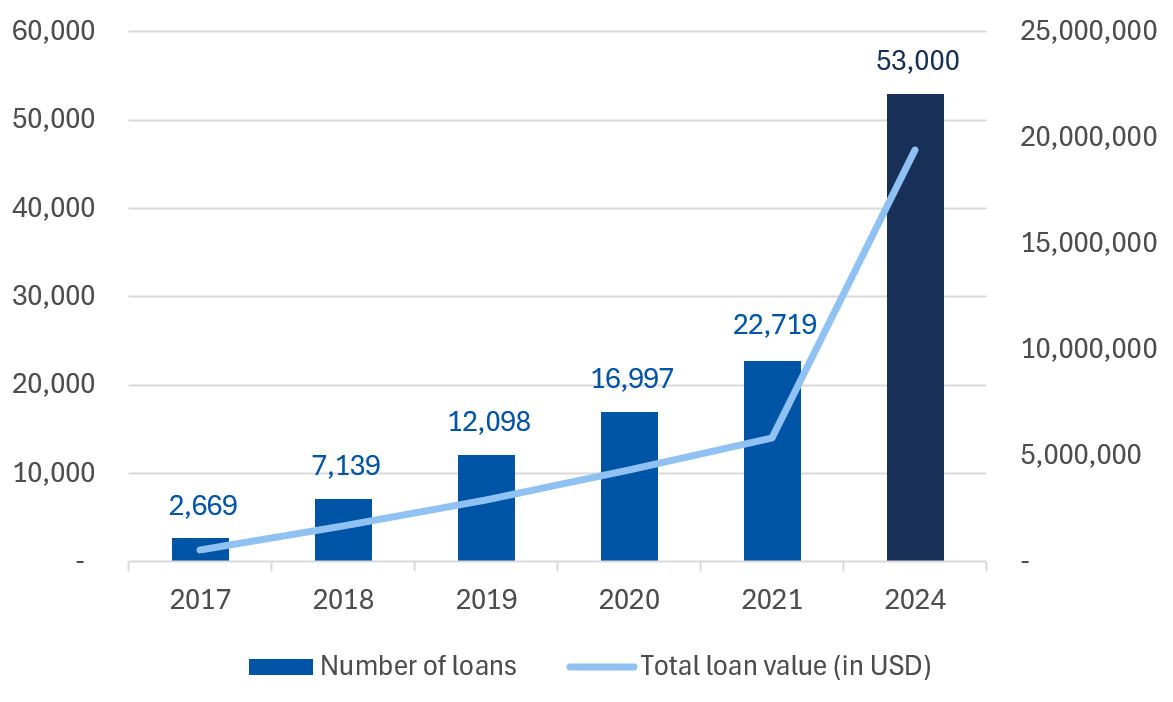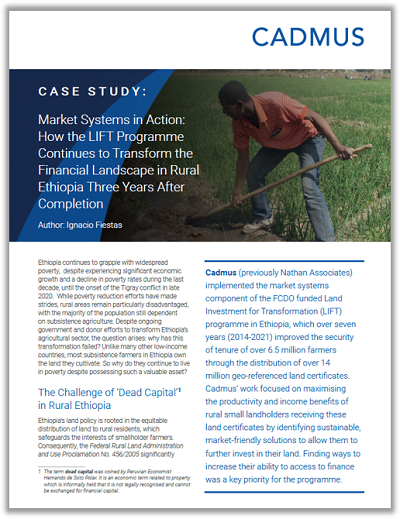Driving Lasting Change in Ethiopia’s Rural Financial Landscape
The ambitious challenge of breathing life into dormant wealth and changing Ethiopia’s rural financial landscape
Imagine owning an asset but being unable to use it to secure a loan. This was the harsh reality for 13.5 million rural households in Ethiopia until recently. Their land, their most valuable possession, was essentially “dead capital”—a term coined by economist Hernando de Soto to describe assets that can’t be easily bought, sold, or used as collateral.
The Land Investment for Transformation (LIFT) programme,1 funded by the UK’s Foreign, Commonwealth & Development Office (FCDO), distributed over 14 million geo-referenced land certificates to more than 6.5 million farmers. Cadmus, in partnership with DAI, took on an ambitious challenge of breathing life into this dormant wealth and changing Ethiopia’s rural financial landscape.
Embracing the Challenge
In 2014, Ethiopia’s smallholder farmers faced a significant financial barrier. Despite having indefinite rights to use their land, they could not leverage it as collateral for loans from financial institutions. This prevented millions from capitalizing on their most valuable asset. While the law granted them indefinite rights to use their land, restrictions on transferring those rights meant they could not use their land effectively.
Despite previous attempts and high risks, the LIFT programme aimed to shift the status quo. Its ambitious goal was to collaborate with the country’s microfinance institutions to develop an agricultural loan product that used newly issued land certificates as a form of guarantee. This type of loan did not exist in Ethiopia; smallholder farmers had previously relied on small group loans, which were insufficient for the large-scale investments needed to transform agricultural productivity.
However, two key constraints had to be respected:
- Land could not be used as collateral, as it belongs to the state and the Ethiopian people.
- The right to use the land belongs to smallholder famers and could not be taken away from them indefinitely.
Thinking Outside the Box
To overcome these challenges, Cadmus and its partners needed to think creatively. They required a solution acceptable to both microfinance institutions (which needed to endorse the new product) and the Government of Ethiopia (which had to comply with the existing legal framework).
The solution they developed was both simple and innovative: instead of collateralizing the land itself, microfinance institutions would use the potential produce of the land as collateral. In the event of a loan default, the institution would temporarily acquire the right to use the land and could recoup losses by renting it out to another smallholder farmer. To limit risks, the loan amount was capped at the projected value of the land’s production for up to two years.
The initial results were promising. By the end of the LIFT program in June 2021, over 22,000 loans had been disbursed, totaling ETB 720.7 million ($5.8m) (figure 1), through eight microfinance institutions. These loans not only helped farmers increase investment and productivity but also benefitted vulnerable groups, including women-headed households. Importantly, government bodies, from land administration offices to the National Bank of Ethiopia, recognized the value of the new loan product in transforming the financial landscape for rural farmers.
Figure 1. The growth path of the new loan product. By June 2021, when the programme ended, 22,719 loans had been disbursed with a total loan value of ETB 720.7 million ($5.8m) through eight microfinance institutions. Source: Internal LIFT monitoring data

Systemic Change, Policy Shifts, and Long-term Positive Impact
LIFT achieved a breakthrough in October 2017 when Ethiopia’s Amhara region approved a new land policy, explicitly allowing farmers to present their land-use rights as collateral to access credit—a significant departure from the previous legal framework. Soon after, the Benishangul Gumuz adopted similar amendments. Today, similar provisions have been included in the draft federal proclamation and regional proclamations of Oromia, Tigray and Southern Nations, Nationalities, and Peoples’ Region, which are pending final ratification.
These changes in Ethiopia’s policy framework set the stage for wide transformational change. Three years after the programme ended, the number of individual agricultural loans continues to increase. A recent paper presented at the 2024 World Bank Land Conference by Hailu Kassaye2 shows that as of 2024, the new loan product has further expanded to 15 microfinance institutions, disbursing 53,000 loans with a total loan value of ETB 2.4 billion ($19.5m).
This marks a true systemic change. Ethiopia’s financial sector is expanding its use of this commercially viable instrument, and the government is adapting its legal framework to facilitate the process. Collateralizing rural land is no longer seen as a radical idea; rural small landholders now have greater access to the capital they need to transition from subsistence farming to more productive, commercial agriculture. The irreversibility of this transformation process was confirmed by Mr. Eyob Tekalign, State Minister of Fiscal Policy and Public Finance at the Ministry of Finance ahead of the May 2021 elections:
“The country’s policy has been against agriculture for a long time. In the past there was no way our finance institutions could finance agriculture for lack of collateral. The new proclamation allows movable properties to serve as collateral thus helping banks to provide loan to farmers and bring about revolution.”
LIFT’s creative approach, combined with the evidence and impact of the new loan product’s success, has led to a profound shift in attitudes and policies in Ethiopia. As de Soto noted, “the problem was not people but the law, which was discouraging and preventing people from being more productive.”
Today, thanks to LIFT, Ethiopia’s farmers are no longer burdened by “dead capital”—they are driving the country’s agricultural transformation.
1 LIFT was funded by UKAid between 2014 and 2021. It included three components: large scale issuance and distribution of geo-referenced land certificates; digitalization of the rural land registry; and enhancing the ability of farmers to benefit from their land certificates. LIFT: Land Investment for Transformation (beamexchange.org)
2 Hailu Kassaye, Rahel (2024) “Developing rural land registration incentive and benefit mechanism and improving urban cadastre in Ethiopia”. Paper presented in the 2024 World Bank Land Conference.
